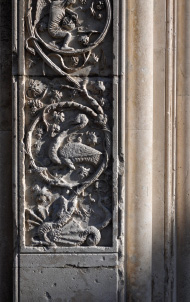![]()
THE artistic riches of the Marche can be experienced in microcosm at Fermo, the successor of the Roman Firmum Picenum, set on a hill some five miles inland from the Adriatic shore.
High above the centre of the town is the Duomo; the front with an elaborate portal survives from the structure of 1227 designed by Maestro Giorgio da Como, but the interior was reconstructed from 1781 onwards. To the right of the entrance, in the surviving west bay of the early church, is Tura da Imola’s signed monument to Giovanni Visconti di Oleggio (d. 1366), one of the series of noblemen who held the signoria of Fermo in the late medieval period. In a chapel on the right is a much revered eleventh-century Byzantine icon of the Virgin, but the most appealing altarpiece is that of the Cappella del Sacramento, the Circumcision by the late Cinquecento Florentine painter Andrea Boscoli, whose melting forms and subtle sense of colour secured him a number of commissions in the area. The great treasure of the Duomo, now in the adjacent Museo Diocesano, is the so-called chasuble of Saint Thomas of Canterbury, which, as an Arabic inscription establishes, was made at Almeria in Spain in 1116.
Fermo’s churches and brick palaces cluster happily. And the central Piazza del Popolo is particularly appealing, with the Loggiato of San Rocco of 1528 and, at the north end, the handsome baroque Palazzo degli Studi opposite the Renaissance Palazzo Comunale, which houses the Pinacoteca. The patrons of medieval Fermo had to look to artists from outside their town; the polyptych of 1369 was supplied by a diligent itinerant, Andrea da Bologna, while the Madonna of Humility is by that delicate Fabrianese magician, Francescuccio Ghissi. The eight scenes from the life of Saint Lucy of about 1410–12 by the Venetian Jacobello del Fiore are among the narrative masterpieces of their age. The surprise of the museum is the Nativity of 1608 by Rubens. Near this is a Seicento masterpiece, Lanfranco’s contemplative Pentecost.

Duomo, west door (detail).